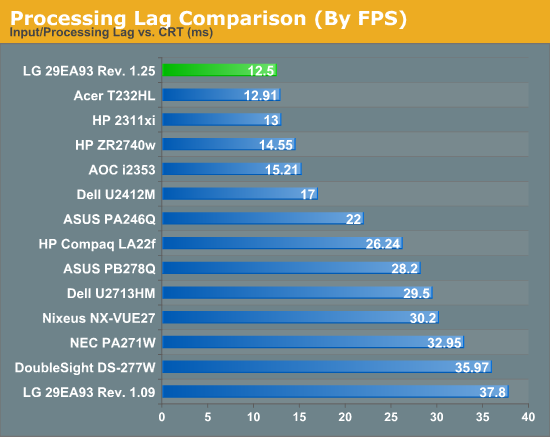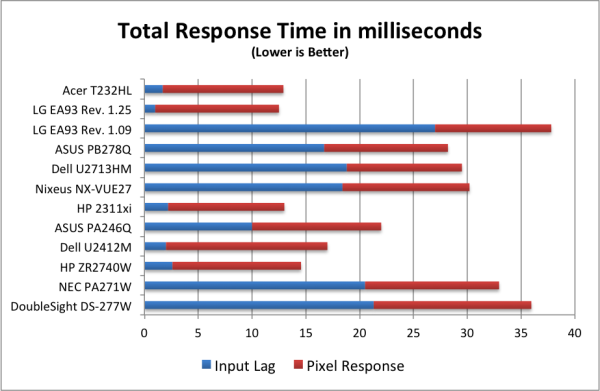LG 29EA93 Monitor Review - Rev. 1.25
by Chris Heinonen on February 12, 2013 8:49 PM ESTWith the 29EA93 being targeted towards gamers, where it can offer a wider field-of-view for games in comparison to standard 16:9 monitors, the poor lag performance of the original model was a big issue. Serious gamers would not put up with that, and so it was not connecting with its target market. With the new revision, lag is virtually non-existant. With the caveat of having to test at 1920x1080 instead of 2560x1080 due to CRT limitations, the LG exhibited 1ms of input lag with my testing. Previously we saw 27ms of input lag, so this is a completely different level of performance. Testing with the HDMI input and not the DVI input led to the same results.
Disabling the game mode only introduced another 1-2ms of lag, but at the expense of image quality, so I would leave it disabled. The total lag from input and pixel response was between 9 and 15ms. I say between because the LG 29EA93 appears to have a scanning backlight that doesn’t match-up perfectly to the refresh rate. Because of these different blanking intervals, the refresh rate of pixels can change slightly, so there is a range of response times instead of constant ones.
I also tested lag using a lag tester from Leobodnar.com, which uses an HDMI output and runs at 1080p resolution. Using a photo sensor it flashes a pattern on the screen and then senses the flash, then updates the screen to have the total lag time. Using this device I got the same results as with SMTT, between 9.6 and 15.8 ms of lag. The downside of this method is there isn’t a separate input and pixel lag time test, but it works much faster and seems to be highly accurate in my testing of it. Unless there is significant feedback about SMTT being superior to this, it might be the method I use in the future.

Due to interest, here are some screenshots showing the difference between 1920x1080 and 2560x1080 in games. I will attempt to add some more before returning the display.
Compared to the previous version, power use is 2 watts higher with both maximum and minimum backlight. That's close enough to be simple variance between units, so we won't worry about it.


















108 Comments
View All Comments
cheinonen - Thursday, February 14, 2013 - link
Since there seems to be a lot of feedback from those worried about the fact that LG provided a new sample that tested well, I decided to add some more comments about the matter, and clear some things up.- The first sample was also hand delivered by LG to me. Every monitor sample I have had has been from a PR company or a company directly, and none of them have been bought by myself.
- If it was so easy or even possible to hand-tune a sample to have the performance offered by Rev. 1.25 of the 29EA93, then wouldn't we expect every monitor that comes in for review to be that good? As it is, samples arrive that perform good and bad. You can look at the Acer monitor that was just reviewed to see it had issues (I had to manually loosen a screw to get the stand to work correctly, which they said would be fixed) and wasn't hand-tuned.
- You can also look at my Nixeus sample that had a brightness control issue, or many other display reviews that have been published. If it was so easy to game the system, every vendor would do it.
- Buying samples just isn't realistic. Most displays arrive for 30 days at most before going back to a company. Many arrive well before the street date so that reviews can be completed and published on the release date. This isn't possible if you need to purchase units, besides being cost prohibitive. Yes, some places would let me return them, but I have ethical issues about buying something I know I'll return, and then they will have to sell at a discount.
If I thought what LG was doing was in any way biasing my coverage, I wouldn't do it, but what they have done as far as providing samples is no different than any other company. What is different is their taking feedback and using it in a positive way, whereas many other vendors might try to deny the findings or just cut off communications, both of which have happened to me before. Being skeptical is fine, but I find no reason to think that LG wanted to anything else other than make a better product than they initially released, and providing the display to me is not different from the normal review process in any way at all.
5150Joker - Saturday, March 23, 2013 - link
Chris, LG should provide some of us a clear route to firmware upgrades that have purchased their displays. That I think is the chief concern among many of us that are concerned about buying an older version. If they were to release the updated firmware on their website in a reasonable time frame (say 1 month from now) with an easy path to upgrade, then nobody would be worried. As it is now, there is no way to differentiate between the older and newer model. This isn't limited to this model either, the LG 27EA83-D has the same problem. A korean website (www.playwares.com) was hand delivered a tuned unit and their lag tests were phenomenal. Unfortunately, I'm one of the people that already owns the 27EA83-D and would hate to be left out in the cold w/an early firmware. LG has a responsibility to clarify and rectify this situation for its customers.avihut - Thursday, February 14, 2013 - link
I was wondering which resolutions does the screen support?I mean does it only support the optimal 2560x1080 at this ratio or does it have something equivalent in the area of 1920x800 or even lower. My machine won't be able to do 2560x1080 on all my games, so I want to know if I'd be able to fall back on lower res but still get the same ratio.
Awesome review. Looks like a superb display.
cheinonen - Thursday, February 14, 2013 - link
With non-native resolutions you can have them scale to fit the screen, or do 1:1 pixel mapping for them.avihut - Friday, February 15, 2013 - link
But will the ratio preserve or will I have to play in letterbox mode?I wouldn't want to stretch 1920x1080 on this screen, since everything will look, well, stretched.
SpartanGR - Thursday, February 14, 2013 - link
How can we tell the diff between the old and the new one if i want to buy it?SpartanGR - Thursday, February 14, 2013 - link
Why can't we just firmware update our monitors? sigh....sheh - Thursday, February 14, 2013 - link
The start of the firmware-upgradable-monitor era? :) "Hey, I just overclocked my monitor using RadFirmware! Plus, scaler mode selection!"Why would TV-range chroma/luma affect contrast? It's supposed to be displayed expanded to the full range, no?
What quality differences are there in game mode?
Anyway, not the monitor for me. Waiting for some 3840x2400 24" 120Hz. OLED wouldn't hurt either, but that can wait another year or two.
cheinonen - Friday, February 15, 2013 - link
When calibrating for TV/Blu-ray/non-PC video, 16 is video black and 235 is video white, as opposed to 0 and 255 with PC content. The monitor shouldn't expand this, so you're calibrating to a smaller range. You can find some devices that will expand video content to the full RGB range (often labeled as RGB Full) that would then use the 0-255 range. For standard video content you only use a subset of that, so you'll have less dynamic range compared to PC.The PC mode was certainly bluish, with a higher color temperature, with fewer adjustments available in order to remove processing lag.
sheh - Saturday, February 16, 2013 - link
That's odd. I'd expect monitors in "TV mode" to expand 16-235/240 to 0-255, just like decent PC software players/decoders. Or maybe whatever feeds the video should do that. Or more like, either one, depending on the settings you select.Well, thanks.